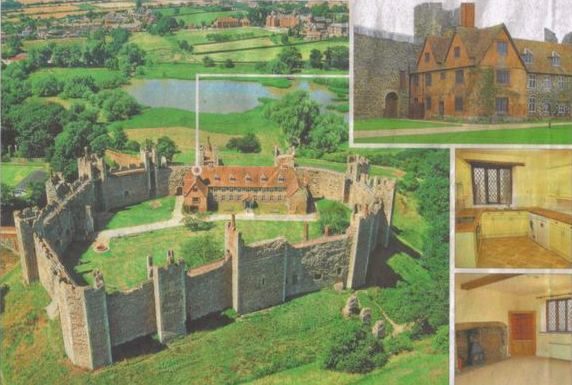 Wednesday - March 02, 2011
Wednesday - March 02, 2011
Breaking News
Posted by Christopher
Filed Under: • History •
• Comments (1)
 Monday - February 28, 2011
Monday - February 28, 2011
not certain if it qualifies as a castle but no matter, you could call this place home.
Seem to be in a history mode here.
Boo-Hoo ... I have only a few minutes and must be off to see dentist. Waaaaaaa.
My home is my castle?
This sort of thing is eye candy to me.
Take a look.
A castle to call home. There’s a catch.
For £850 a month, English Heritage is looking to rent out a three bedroom property in the grounds of Framingham Castle in Suffolk. The red house was formerly staff accommodation at the castle, which was built in the 12th century by the 1st Earl of Norfolk.
The successful tenants will have the grounds of the castle to themselves after sightseers have left for the day.
Newspaper blurb with photo did not say if any duties were involved but I doubt it if you’re paying EH. Wonder if they have internet connection to that place. Prolly only dial up. I mean, how close to the BT junction can this place be? Doubt much it’s close at all so forget broadband unless BH allows satilite hookup somewhere out of sight.
Clicking anywhere on the photo will bring you to more info on this place, as well as more pix. Interesting stuff.
Posted by peiper
Filed Under: • Architecture • History •
• Comments (4)
‘Don’t know much about History…’
1827 - The Baltimore & Ohio Railroad is incorporated, becoming the first railroad in America offering commercial transport of both people and freight. Obama would like to go back to the 19th century.
1854 - The Republican Party is organized in Ripon, Wisconsin. Oh the irony!
1885 - AT&T is incorporated in New York State.
1935 - DuPont scientist Wallace Carothers invents nylon. Oh the fashion!
1983 - The final episode of MASH is broadcast. Alan Alda never recovers.
1993 - Waco, TX: BATF agents raid the Branch Davidian church with a warrant to arrest David Koresh. Four BATF agents and five Davidians die in the initial raid, starting a 51-day standoff. President Clinton is clueless, passes to AG Janet Reno.
Posted by Christopher
Filed Under: • History •
• Comments (0)
 Sunday - February 27, 2011
Sunday - February 27, 2011
‘Don’t know much about History…’
1594 - Henry IV is crowned King of France
1797 - The Bank of England issues the first one-pound and two-pound notes.
1801 - Pursuant to the District of Columbia Organic Act of 1801, Washington D.C. is placed under the jurisdiction of the U.S. Congress, which still annoys Eleanor Norton Holmes.
1812 - Lord Byron gives his first address as a member of the House of Lords, in defense of Luddite violence against industrialism in his home county of Nottinghamshire. Lord Byron would approve of union protests in Wisconsin, Ohio, etc.
1939 - The U.S. Supreme Court rules that sit-down strikes violate property owners’ rights and are therefore illegal.
1951 - The 22nd Amendment to the U.S. Constitution, limiting Presidents to two terms, is ratified.
1973 - The American Indian Movement occupies Wounded Knee, S.D.
1974 - Screw Up Your Life People Magazine is published for the first time.
1991 - First Gulf War: President George H. W. Bush announces that ‘Kuwait is liberated.’
2003 - Rowan Williams (the Insane) is enthroned as the 104th Archbishop of Canterbury.
Posted by Christopher
Filed Under: • History •
• Comments (0)
 Thursday - February 17, 2011
Thursday - February 17, 2011
Another Non-Merde Moment From France
French President Nicolas Sarkozy has joined the chorus. The other day, he said, “My answer is clearly yes, it is a failure.” The “it” was multiculturalism, and he was on French national television. In pronouncing multiculturalism defunct, the French president joins German Chancellor Angela Merkel, former Australian Prime Minister John Howard, Spain’s former Premier Jose Maria Aznar and, most recently, British Prime Minister David Cameron in heaving a failed policy into history’s dustbin.
“If you come to France, you accept to melt into a single community, which is the national community, and if you do not want to accept that, you cannot be welcome in France,” Mr. Sarkozy explained.
So how did the Europeans end up with multiculturalism, a multiculturalism that seems to favor Islam over other cultures? The Germans have outlawed Nazi culture. The Italians are not particularly hospitable to fascism, and as I have already pointed out, the French are appalled at cannibalism and do not even have a good word for McDonald’s or KFC. I think it started with the way they teach their history. Militarism, colonialism and racism are all prominent ingredients of European history, particularly British history. For that matter, American history also stresses these ingredients. I have been reading American college history texts, and they present an alarmingly ugly view of the Western past.
By presenting the West as repugnant and other civilizations as our prey, particularly during colonial days but also in modern times, we encourage such social pathologies as jihadism. Mr. Sarkozy says he is not going to tolerate the kind of fundamentalism in France that leads ultimately to jihadism. How is he going to achieve this without calling for a fundamental reform in how French history is taught?
There’s more to read if you want.
The very first comment is all, Hey, where’s Obama in this? How come he hasn’t figured it out yet?
Posted by Drew458
Filed Under: • History • Patriotism • Politically Correct B.S. •
• Comments (3)
 Wednesday - February 09, 2011
Wednesday - February 09, 2011
Inventive Weaponry

Using his own ingenuity, a welding torch, and some spare parts lying around the shop, a gunsmith has built a rather unique firearm. He figured things out as he went along, and came up with what may be the first lever operated single action revolving cylinder shotgun ever made. Pretty neat. In the above picture the teardrop shaped knob you see behind the cylinder is the handle for the swing out loading gate, just like on a single action revolver. The ejector rod assembly runs along the right side of the barrel over the forearm and is used just like the ones on a single action revolver. The shotgun has a great 1880s look to it, right down to the red color of the wood which was popular in those days.
This is one of those posts that takes me forever to write, because I can see several approaches to it. I love the “lever action revolver shotgun” part, because it makes me wonder if this gun project wasn’t designed from the get-go to take a swipe at pulp fiction authors, who are historically awful at describing guns. Seriously, they write such colorful nonsense, like “emerging from the misty night, he lifted his .44 millimeter magnum double barreled automatic and drew a cowardly bead on the detective’s head from behind.”, proving yet again that they have even less awareness about actual firearms than Hollywood producers. That’s a challenge, because I didn’t think it was possible to actually have negative quantities of knowledge. So it strikes me that this could have been a “gotcha” project.
The other direction would be to point out that there is nothing new under the sun when it comes to firearms. Everything has been done before, and it was usually done 100 years ago if not longer. Old ideas get reinvented, improved a bit with modern materials and technology, and hit the market as something brand new. The revolver shotgun is one of those ideas. And that’s where a 30 second post of “oh, look at this neat picture, here’s a link, now move on” turns into hours, because I go and do the research so you don’t have to.
The revolving barrel / revolving cylinder idea is probably almost as old as firearms themselves. I would not be at all surprised if some ancient Chinese proto-gun someday turned up that had 5 or 6 bamboo barrels strapped around a wooden axle that allowed the shooter to fire off half a dozen rock balls in quick succession by touching a burning brand to the flash holes. Gunpowder came along a long time after the wheel and the lever, and reloading has always sucked, so the axial repeater is probably Thought #2 when it comes to inventing a better gun.
Metallurgy and ignition methods being what they were, it took until the early 19th century to make a revolver that was even somewhat reliable (the pepper mill pistol) and it wasn’t until the mid 19th century when Samuel Colt figured out how to properly do things. From then until now it’s only been a matter of improved materials and precision, with a few side steps along the way for such tricky bits of innovation like metallic cartridges and smokeless powder.
Somewhere around 1855 Colt enlarged his clockwork pistol mechanism and hung a long barrel off the front of it, thus creating the revolving rifle. It looked really cool but wasn’t very powerful. He further stretched the idea and turned out revolving cylinder shotguns. And between the two long arms, he invented the problem of blow-by. You see, in order for a cylinder to be able to spin around, the front edge of it can’t be in actual contact with the back end of the barrel. You need a little gap so the parts don’t rub on each other. But when you fire a revolver of any kind, some of the burning powder gas is going to squirt sideways out of that gap. So is some of the bullet if the parts aren’t perfectly aligned (and they never are). In a pistol this doesn’t really matter. You hold a pistol in one hand a stick it out in front of you. Any blow-by goes off to the side. But when you grow a revolver into a rifle or a shotgun, your other hand is out in front holding on to the fore end. Which means the blow-by hits you right in the arm. White hot gas and little shavings of high speed lead. Not cool.
Technology has come a long way towards mitigating the blow-by problem. Modern steels and modern machining can make that gap very small; just 2 to 4 thousands of an inch. Modern smokeless powders burn very cleanly. They don’t leave a bunch of sticky crud behind them like the old black powder did. That allows those close gaps to work; no crud builds up on the front of the cylinder to jam things up. Well actually it does, but these days it takes hundreds of shots to build up enough gunk on the front of a cylinder to jam a revolver. Back in the old days a dozen or two shots would have been enough, which is why the old guns had such big gaps between the breech end of the barrel and the face of the cylinder. And more blow-by because of it. So the revolver rifle/shotgun idea didn’t work out too well back in 1860, and it got set aside.
But it wasn’t set aside by everyone. Around 1866 Sylvester Roper found a better way. Roper was a prolific inventor, and like many other inventors of that era he turned his mind in several directions. He built a steam powered car. He may have invented the motorcycle: his was steam powered, and it was one of these two wheeled wonders that eventually killed him. But along the way he also invented a revolving cylinder shotgun, that used metallic cartridges before metallic cartridges were actually invented. So he made his own, out of iron. Chalk up another first for old Sly.

The Roper Revolving Shotgun was highly unusual, and at first glance appears to have solved the blow-by problem by putting a hinged shield around the cylinder (which is Thought #5 in repeating firearms development, once the burns have healed from Thought #2. It works but is really clumsy). This is not the case. Roper built his gun in a recursive, cart before the horse, kind of way so that cocking the hammer retracted a long bolt that ejected the spent cartridge out the back. Pulling the trigger advanced the cylinder, and released the bolt. The spring powered bolt slid forward, pushed the cartridge out of the cylinder and into the breech of the barrel, and then fired it. If you think about it, there had to be some kind of bolt locking mechanism inside somewhere, otherwise this thing would have been a machine gun. Here’s the video:
It’s a pity the NRA curator doesn’t work the mechanism using one or two of the iron cartridges because that would really make it clear how this one functioned. And the curator’s remark about blow-by is ill founded, since firing a cartridge in a locked chamber will have just about zero blow-by. But it was a really neat invention, and you could honestly say that what Roper built was actually a bolt action revolver shotgun, a description which should send detective novel authors into fits of orgasmic glee. Thank God it only had one barrel.
And here’s where the fun begins all over again. With divergence! It must have been a triple bear to cock that hammer, seeing how much mechanical complexity it eventuated. The guy had a good idea, but took what to us was an ass-backwards approach, rather like building a giant skillet under your hen house so your hens would lay fried eggs. It works, but the cost in chickens is going to bankrupt you. Which is exactly what happened to Roper. Like just about every firearms inventor of his time, he went broke. But you can’t keep a good mind down, even if it keeps coming up with backwards ideas rather like our old friend General Buffington, so with his partner Spencer (yes, that Spenser, the guy who invented the Spencer repeating carbine that was used so effectively in the Civil War), he looked at his creation, looked at the new tubular magazine that Henry had hung under his ”Yellow Boy” lever action rifles (this rifle would soon evolve into the Winchester lever action “cowboy rifle”, the so-called “gun that won the West” and make Oliver Winchester millions. Henry also went broke.) and it’s cartridge lifting mechanism, put two and two together, and then invented the pump action shotgun. 11 years before Winchester. More than a century later, the pump shotgun remains essentially the same. It’s prettier, stronger, smoother, better made and better balanced, but today’s model isn’t really much different than what these guys developed way back when.

But in doing so they gave up the revolving cylinder idea. Had they hung onto that, and just added a lever to do all the hard work, they would have built a creation rather like the one shown above that our unnamed inventor put together 130 years later. It would still have the blow-by problem, but perhaps “hardly noticeable with normal shirt sleeve” as our modern inventor at the top claims.
Ah yes, the divergence. Let’s go back to the turn of the 20th century, and take Roper’s revolving cylinder gun idea and add that lever. Let’s shorten the bolt so that the used cartridge gets ejected out of the top of the gun instead of out the back, and let’s make sure the lever does all the mechanical work. While we’re at it, let’s utilize those new fangled carbon steel coil springs so we can get rid of that clunky old hammer and put all the firing pin and striker parts inside the gun. We’ll keep the locking bolt and the idea of pushing the cartridge out of the revolving cylinder and into a chamber in the back of the barrel. Finally, let’s make it a rifle, since the repeating shotgun thing is all figured out. My gun savvy readers are smiling now, because they know what’s coming.

Behold the Savage 99. Arthur Savage did exactly what I said in the above paragraph, and in 1889 brought the rifle to market. It was a hit. He improved the design a little in 1899 when he was trying to get a military contract, but the improvements were mainly in robustness. It’s the same design concept as the 1889 model. Lever action, fully shielded internal rotary magazine (ie revolver cylinder), sliding bolt with a sturdy locking mechanism. No blow-by. For the next 80 years this Savage rifle was the darling of American hunters everywhere. It’s a fast pointing, fast shooting, perfectly balanced little gun that can handle the strongest modern cartridges, and unlike the tubular magazine lever guns made by Winchester and Marlin, the Savage is perfectly happy with pointy bullets. It’s a very robust design without a whole lot of fussy little parts, and that makes for a easy to maintain rifle that lasts forever. Many 99s built many decades ago are still out there hunting today.
Hey, while we’re at it, since the market is clamoring for super high velocity cartridges, let’s put a famous cartridge designer on the payroll, one Charles Newton, and have him develop the hottest cartridge out there to pump up sales! And he did, inventing the .250-3000 Savage, a short little wonder cartridge that could push an 87 grain quarter inch diameter bullet at the unheard of phenomenal velocity of 3000 feet per second. Which means Savage invented the Assault Rifle Cartridge. In 1915. 50 years before such rifles even existed, and 75 years before they got that label. Just for fun, a few years after that Savage took the .250 cartridge and necked it up to .308, and made a short length cartridge that matched the ballistics of the popular military .30-06: a 150 grain bullet at 2700fps. The .300 Savage is a fantastic deer hunting round, and did the “short action” thing 50 years before the rest of the market had “invented” the idea.
Like I said, there’s nothing new under the sun in the firearms world.
h/t to Rich K
Posted by Drew458
Filed Under: • Guns and Gun Control • History •
• Comments (3)
 Thursday - January 27, 2011
Thursday - January 27, 2011
Oh Look
The 1954 Supreme Court decision on Brown v. Topeka Board of Education ruled that “Separate But Equal” schools aren’t. This led the way to de-segregation, and was one of the key decisions that kicked the Civil Rights Movement into high gear.
Here’s a map from Wikipedia:

Golly, that division looks pretty familiar doesn’t it? It almost looks like

from 90 years before. Note that California and Oregon were also part of the Union, and that Oklahoma was not actually a state until 1907. Also see here and here for maps of the CSA that show how Missouri, Kentucky, and the Indian Territories (Oklahoma) were claimed by the Confederacy, along with the southern halves of the Arizona and New Mexico territories. If you consider those “border states” as “indecisive” or “mixed opinion”, then the relationship from back then to the 1954 realities of segregation are quite stunning. Don’t forget that Kansas was an actual battleground over abolition even before the war started.
It would take perhaps an hour to make another map or two, circa 1964; one would show states that historically were Democrat controlled at that point, the other one would show how that state voted on the Civil Rights Acts. I’d bet you’d have at least 80% congruence.
All of this history ... and just last year the Republican Party had a black guy as chairman who said that he couldn’t find a single reason why any black person would vote for his party. Unreal.
Posted by Drew458
Filed Under: • History • Politics • Racism and race relations •
• Comments (2)
 Wednesday - November 24, 2010
Wednesday - November 24, 2010
“General Thanksgiving–A Proclamation”
General Thanksgiving
By the PRESIDENT of the United States Of AmericaA PROCLAMATION
WHEREAS it is the duty of all nations to acknowledge the providence of Almighty God, to obey His will, to be grateful for His benefits, and humbly to implore His protection and favour; and Whereas both Houses of Congress have, by their joint committee, requested me “to recommend to the people of the United States a DAY OF PUBLICK THANKSGIVING and PRAYER, to be observed by acknowledging with grateful hearts the many and signal favors of Almighty God, especially by affording them an opportunity peaceably to establish a form of government for their safety and happiness:”
NOW THEREFORE, I do recommend and assign THURSDAY, the TWENTY-SIXTH DAY of NOVEMBER next, to be devoted by the people of these States to the service of that great and glorious Being who is the beneficent author of all the good that was, that is, or that will be; that we may then all unite in rendering unto Him our sincere and humble thanks for His kind care and protection of the people of this country previous to their becoming a nation; for the signal and manifold mercies and the favorable interpositions of His providence in the course and conclusion of the late war; for the great degree of tranquility, union, and plenty which we have since enjoyed;-- for the peaceable and rational manner in which we have been enable to establish Constitutions of government for our safety and happiness, and particularly the national one now lately instituted;-- for the civil and religious liberty with which we are blessed, and the means we have of acquiring and diffusing useful knowledge;-- and, in general, for all the great and various favours which He has been pleased to confer upon us.
And also, that we may then unite in most humbly offering our prayers and supplications to the great Lord and Ruler of Nations and beseech Him to pardon our national and other transgressions;-- to enable us all, whether in publick or private stations, to perform our several and relative duties properly and punctually; to render our National Government a blessing to all the people by constantly being a Government of wise, just, and constitutional laws, discreetly and faithfully executed and obeyed; to protect and guide all sovereigns and nations (especially such as have shewn kindness unto us); and to bless them with good governments, peace, and concord; to promote the knowledge and practice of true religion and virtue, and the increase of science among them and us; and, generally to grant unto all mankind such a degree of temporal prosperity as he alone knows to be best.
GIVEN under my hand, at the city of New-York, the third day of October, in the year of our Lord, one thousand seven hundred and eighty-nine.
(signed) G. Washington
Source: The Massachusetts Centinel, Wednesday, October 14, 1789
Hmmm. No mention of Pilgrims. Or Squanto. Just giving thanks to God, which ‘is the duty of all nations…’
Indeed, the duty of all nations, Presidents, Congress-critters, and citizens is to give thanks to God.
Atheist? Got ya covered:
“The worst moment for the atheist is when he is really thankful and has nobody to thank”
––Dante Gabriel Rossetti
To those who might be ‘offended’ by this post: either learn some ‘tolerance’ or seek psychiatric treatment.
Posted by Christopher
Filed Under: • History • Holidays •
• Comments (7)
 Monday - November 22, 2010
Monday - November 22, 2010
The only picture to show what Henry VIII’s spectacular ‘lost’ palace really looked like.
I don’t suppose there are too many people really knocked out by this. But I am and so am posting it.
Wow ... what a shame it was torn down. Progress and gambling debts. Spells disaster for places like this.
Take a look.
Glimpse of a ‘lost’ palace: Only realistic painting of Henry VIII showpiece torn down by a royal mistress goes on sale for £1m
By Daily Mail Reporter
Last updated at 4:17 PM on 22nd November 2010The only picture to show what Henry VIII’s spectacular ‘lost’ palace really looked like is to tipped to sell for more than £1million.
The incredibly rare 450-year-old painting depicts Nonsuch Palace in its full glory, after it was commissioned by the King to outshine his greatest rival King François I of France.
The expensive and extravagant building was named Nonsuch as it was said no other palace could equal its magnificence.

But it stood for only 150 years until Charles II’s mistress tore it down and sold off the materials to pay off her gambling debts.
Despite its contemporary fame, the lost palace was only depicted four times before crumbling into disrepair by 1690.
Of these, only one painting - a watercolour by Joris Hoefnagel published in 1572 - is believed to show its true likeness.
The three others - an exaggerated thumbnail by John Speed in 1610, a painting by an unknown artist in 1620 and a view by Hendrick Danckerts in 1660 - are not considered accurate.
The Hoefnagel painting is now being sold at auction by Christie’s on December 7, and is expected to fetch up to £1.2million.
The watercolour is one of the oldest painted in this country, was painted in situ at the palace near Ewell in Surrey, In the late 19th century, it was acquired by art connoisseur Alfred Morrison and passed down his family line. It is now being sold by a private vendor.
It captures the ornate building as it was in the 16th century, shortly after it was completed to King Henry VIII’s demanding standards.
Posted by peiper
Filed Under: • Architecture • History • UK •
• Comments (3)
 Thursday - November 18, 2010
Thursday - November 18, 2010
Relics from Richard II’s tomb found in National Portrait Gallery
History,history. This place keeps giving up it’s past. Thought I’d share this too.
Relics from the tomb of Richard II have been unearthed by an archivist in unopened boxes at the National Portrait Gallery.
By Heidi Blake
Fragments of wood, leather and fabric from the coffin of the medieval English king, who died in 1400, were found in a cigarette box, along with sketches of the king’s skull and bones.
The relics were discovered by an archivist cataloguing the papers of the gallery’s first director, Sir George Scharf, who died in 1895.They were found among the hundreds of diaries and notebooks left behind by Sir George in unopened boxes, and were identified by cross-referencing the date on the cigarette box with diary entries and sketches made on the same day - August 31, 1871.
Records show that Sir George was present when the Richard II’s grave was exhumed at Westminster Abbey.He frequently attended exhumations and also witnessed the opening of the graves of Richard II, Edward VI, Henry VII, James I and Elizabeth of York.
His sketches of the king’s skull and bones are so faithfully drawn that archivists believe they could be used to reconstruct the king’s appearance.
A piece of leather found in the box corresponds closely with a sketch by Sir George of a glove contained in the coffin.
Posted by peiper
Filed Under: • Archeology / Anthropology • History •
• Comments (2)
ancient manuscript expected to fetch up to two million at auction
What greatly surprises me is the price. 14th century and the subject matter? If I had that kind of pocket money I’d bid till I owned it. Then give it to the British Museum, I swear I would. It belongs here, nowhere else. Gosh I would love to actually see this and maybe even hold it. Now this is treasure. See the link for more and bigger pix.
Amazing that they could put this together. No electricity, no computers, no photoshop.
The Holy Grail of manuscripts: 14th century King Arthur text to be auctioned at Sotheby’s
By Daily Mail Reporter
A 14th century manuscript containing what is believed to be the oldest surviving account of the legends of King Arthur is to be sold for up to £2 million, it was announced today.
The Rochefoucauld Grail, a colourful, illustrated account of the knights of the round table is said to be one of the finest medieval texts in private hands.
It is due to be sold by auction house Sotheby’s in London for a price estimated between £1.5 million and £2 million.
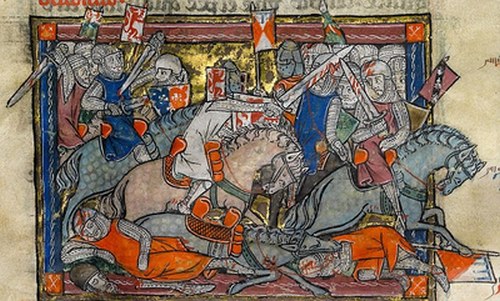
Blood and guts: This picture from the manuscript shows King Arthur fighting the Saxons.
More than 200 cows would have been needed to produce the vellum sheets for the three hefty volumes of the manuscript, which contains 107 finely painted illustrations.
It was written in Flanders or Artois some time between 1315 and 1323 and probably produced for Guy VII, Baron de Rochefoucauld, head of one of the leading aristocratic families of medieval France.
The manuscript went on to be acquired by 19th century collector Sir Thomas Phillipps and has changed hands twice since.

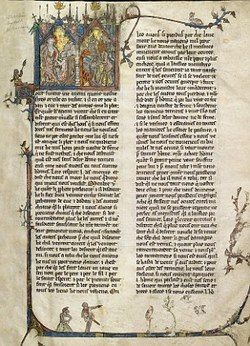
Lady in the lake: The image on the left depicts the lady with Sir Lancelot as a baby, while the image on the right shows the intricate details are not left just to the illustrations
Posted by peiper
Filed Under: • Art-Photography • History • UK •
• Comments (0)
 Sunday - October 31, 2010
Sunday - October 31, 2010
Nail ‘em on it!
The contrast could not be starker.
Imam Obama, since His Inauguration, has done nothing but attack Americans.
He’s attacked the auto industry.
He’s attacked the oil industry.
He’s attacked my doctors.
He’s attacked my insurance companies.
He’s attacked my bank.
He’s attacked ‘Wall Street’ where I invest my retirement funds.
He’s attacked mortgage companies for complying with Federal law. Forcing you and me to pay for deadbeats.
He’s attacked my restaurants.
He’s attacked the Chamber of Commerce.
He’s attacked you and me as ‘clinging to our guns and religion.’
He bows to foreign despots.
He apologizes for your and my alleged ‘sins’ from the past.
I could continue the list of attacks Imam Obama has perpetrated upon the American people. It is (so far) endless.
In fact, the only people he hasn’t attacked are the actual enemies of the United States.
Islam.
Illegal ‘immigrants’ (I call them hostile invaders).
China.
He does NOT represent America.
Remember when we had a President who did represent America? Maybe not in practice, but the goal which is worth striving for?
I know of no Democrats, and pitifully few Republicans, who stand for the Constitution and America.
We’re two days from an historical election. The choices are clear: you can vote Democrat. Or you can vote America.
You cannot vote for both.
Posted by Christopher
Filed Under: • Democrats-Liberals-Moonbat Leftists • Editorials • Government • History •
• Comments (4)
 Friday - October 29, 2010
Friday - October 29, 2010
Out of the Black and Into the Blue
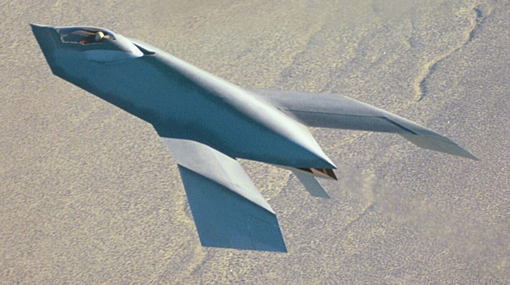
This is a one of a kind test aircraft made by Boeing called the Bird Of Prey. Once upon a time it was the blackest of black projects, but it was declassified and shown to the public back in 2002. It was built with as many off the shelf parts as possible to keep the project cost down $67 million. It could neither fly high nor fast, and was a handful to land. And it seemed to generate UFO reports whenever it flew. I wonder why?

From a 2002 news release: Named after a Klingon spacecraft in “Star Trek,” The Boeing Co. yesterday took the wraps off what was once one of its most classified “black” military airplane projects known as the “Bird of Prey.”
The Bird of Prey plane is 47 feet long with a distinctive 23-foot wing at the rear shaped like a “W.” The Boeing project ran from 1992 through 1999. The plane, which looks like something that should be flying—and probably once did—at the super-secret Area 51 Nevada test range, helped Boeing pioneer stealth technology and new and more-affordable ways to design and build airplanes. The classified project ran from 1992 through 1999, and Boeing said it decided to make the aircraft public because the technologies that were demonstrated have become industry standards.“With this aircraft we changed the rules on how to design and build an aircraft, and what we’ve learned is enabling us to provide our customers with affordable, high-performing products,” said Jim Albaugh, president and chief executive of Boeing’s Integrated Defense Systems.
It was developed by the McDonnell Douglas Phantom Works organization, where many black, or secret, projects for the military ended up, just as they did at the famed Lockheed Martin Skunk Works.
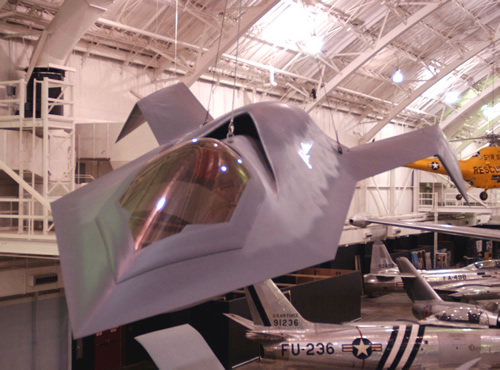
The Bird of Prey incorporated a variety of stealth features to minimize radar, infrared, visual and acoustic signatures. The overall shape of the low profile, tailless, blended fuselage with sharply cranked aft-set wings contributed to an extremely low radar cross-section. Flexible covers concealed gaps between fixed structures and moveable control surfaces. Designers were careful to ensure edge alignment on the canopy, landing gear doors, wings and fuselage to minimize radar backscatter. To eliminate radar reflections from the engine compressor face, the powerplant was buried deep in the fuselage and hidden behind the canopy and a curved inlet duct. The engine exhaust mitigated the airplane’s acoustic signature. A paint scheme consisting of several shades of gray reduced the visual contrast of shadows from various parts of the airplane. All of these features would contribute significantly to the survivability of an operational combat airplane.
As the team learned the lessons of each flight, the test program proceeded at a leisurely pace. Only 38 missions were flown between September 1996 and April 1999, roughly one sortie per month.
A video is here.
Funny thing though ... all the articles out there keep saying the aircraft was built to pioneer stealth technology. In 1992. Even though the F-117 and B-2 stealth aircraft had been in the field since the early 80s, which means they’ve been around since probably the early 70s. So what’s the point of “pioneering” it in the early 90s? Well, take your pick:
a) it was pioneering work for Boeing, because the other stealth planes were built by Lockheed/Martin/Marietta and Northrop Grumman. So when Boeing bought out McDonnell/Douglas, who had started the project, they actually had no stealth experience themselves, so this was a prove-we-can-do-it project ... or
b) the real purpose of the project is still deep in the black. They only tell us it was a stealth demonstrator and a low performance flying testbed. Was this an early Aurora prototype? The truth really isn’t out there; we will never know for sure.
Posted by Drew458
Filed Under: • High Tech • History • planes, trains, tanks, ships, machines, automobiles •
• Comments (2)
 Wednesday - October 20, 2010
Wednesday - October 20, 2010
Where ya bin?
Not much posting from me the past few days. What time I’ve had for internet surfing has been eaten up studying. Yeah, I went down another one of those digital tangents, and got deep into some seriously esoteric knowledge. It happens.
It all started when I read something about some Viking raid back in the late Dark Ages. And the memory that those guys used something called a “klondorf” sword popped into my head. And that got me Googling. Well, it turns out that it wasn’t “klondorf” it was “clontarf”, named after a long ago battle in Ireland in which the Vikings got whupped but good.

I was pretty amazed that the minute by minute details of that battle were still known, along with all the political squabbling, temporary alliances, and dirty deeds that lead up to it. It’s a colorful story in the best Irish tradition, and in the end there are no real winners. Oh sure, the battle itself was quite decisive. But afterwards the folks went right back to squabbling and dirty dealing, so nothing was really gained by it.
But it made me think of just how courageously mad and how physically strong these warriors must have been to go at it in the dirt with these massive choppers, protected by little more than a leather shirt and a wooden shield. So I looked into it, and found out some things that I thought were very interesting. And that’s when I got on the Express Bus to ride down Esoterica Street.
For starters, swords were much lighter than I realized. I was a fencer in college, and the foils, epees, and sabres we used all weigh only a few ounces. A pound at most, IIRC. That doesn’t count; that’s modern sporting equipment. But I’ve got some sort of cultural memory, fueled by Bugs Bunny cartoons and Errol Flynn movies in which the plucky princess can barely lift a sword in emergency circumstances to save her own honor ... these things had to weigh a ton, yes? No. Surprise! A broadsword, any broadsword, from the early kind the Vikings used right up until they went away in the early days of the Renaissance, only weighed about 2 1/2 pounds. The seriously huge ones, like the double handed Claymores, only weighed a pound more. Nor were they point heavy imbalanced cudgels; thousands of ancient swords are still around, and almost all of them balance within a hand-span of the hilt. And they were sharp. We tend to denigrate the skills of the ancients these days, poo-pooing their feeble efforts in just about everything. But we are wrong to do so. Vainglorious. These guys may not have turned out 5000 tons of chromaloy steel a day like today’s mills, but what they wrought, they wrought well.
Another thing that really caught me off guard was the flexibility these blades had. I’d never really thought about it, but if anything, I’d figured that they were all stiff as rocks; great clanging iron I beams with a bit of a sharp edge. Wrong again Sherlock. A properly tempered broadsword can flex nearly 90 degrees and still not take a bend. Try that with your fancy kitchen knives! This is a very long way from the smithing process used to make the Roman Gladius, which was a short sword that was very stiff. That one was built up out of bars of twisted wrought iron hammer forged together ... go and read Jack Whyte’s Camulod Chronicles series of novels for a very detailed explanation of that process ... plus it’s a great read, and a wonderful telling of the “coulda been” story of the shaping of early Britain behind the Arthurian legend. Well, read the first 6 novels in the series. The last few books aren’t as good; the series really ought to have ended with Metamorphosis with young Arthur, the newly crowned Christian high king, rushing off to his first major battle, Excalibur in hand.
Then I found out that the evolutionary history of edged weapons has been classified by this guy Ewert Oakeshott, who spent the better part of his life studying the things, and developed the typology used by everyone today that shows the kind of swords used, who use them, where, and when. He figured out the arms race of those days, how swords grew and changed across the centuries in response to different armor, different metallurgy, and different ways of fighting wars. Impressive as all get out, and about as esoteric a field of expertise as you could ever hope to find. Which makes it pretty obvious he was an Englishman. Well done, that man.
But I was still interested in the metallurgy aspect. The mining, the smelting, the smithing. I’m still looking into that, still learning. And I think this is the core issue that marks the difference between western swords, those knightly weapons of the Middle Ages, and their counterparts in the Far East, the Katana blades of the samurai. Europe has had iron mines since forever. And coal. And may have had coke ( as charcoal is to wood, coke is to coal ) in small quantities for a very long time. But when they smelted iron their results had either no carbon (wrought iron) or too much carbon (cast iron), and very little steel (just a bit of carbon). Ancient Japan got most of its iron ore from the beaches. They have iron sands. And no coal. So their smelting was done at a much lower temperature, which gave them a non-homogeneous result, but that mixed result had both kinds or iron and both low and high carbon steel in it. This in turn forced the smiths to take an entirely different path to smithing and making weapons. That lead to all that hammering and folding, that near-mythical forging knowledge and level of labor that was required to build those fabled blades. ( for a great, lengthy, but simple read on the history of Japanese steel making, read this. ) Following that path for a bit I learned that a typical Katana was just about the same size and weight as it’s European counterpart, but with a shorter, heavier, but equally flexible blade. Because it was made from mixed steels. And they had a much more forward weight balance, due to their long two-handed grip and not much in the way of a pommel. I had always thought things were exactly the opposite, that samurai swords were the utter peak of the swordsmith’s art in all things, balance included. Horrible snark opportunity: different strokes for different folks!

Tamahagane steel is made by building and firing a Tatara, the traditional Japanese sword-steel smelter. This charcoal- fired furnace produces a very pure steel from iron sand, and this steel ‘’Kera’’ or bloom can be broken and separated into high- and low-carbon pieces, which respectively form the ‘’skin’’ steel and ‘’core’’ steel of the blade. The skin steel is forged and folded repeatedly, to remove slag inclusions and voids and is then wrapped around the core steel before the resulting billet is forged into a blade. Careful heat treating, shaping and polishing reveals the tight ‘’Hada’’ or layer pattern of the blade and the white particles of the ‘’Hamon’’ or temper line. While this process results in the aesthetic qualities much admired by collectors it also produces a very functional blade, as the high carbon content of the skin steel makes a very hard edge possible while the softer core steel gives the blade its resilience and ability to absorb shock.
I took a left turn somewhere along this road and delved into modern swords. Yes, they are out there, and not just the wall hanger bit of crap you can pick up for $24.95 at the mall and use to impress your drunken friends with when cutting watermelons. No, I’m talking real swords. Razor sharp lengths of properly forged and tempered steel, built to slice off heads, chop through chainmail and stab through armor plate. Battle ready weapons, modern heirlooms. Toys for boys with way too much money. Swordmaking is not a lost art; the best of today’s swords are every bit as good as the ones built 600 years ago. Better perhaps, although the very best ones strive to be as authentic as possible, which can mean making a slightly lesser weapon than what current technology could actually produce. They come in every shape and variety and at every price point. So do samurai swords. But eastern or western, the real real deal will set you back between nearly one and a bit more than two thousand dollars.
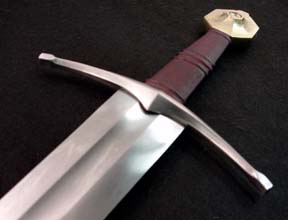

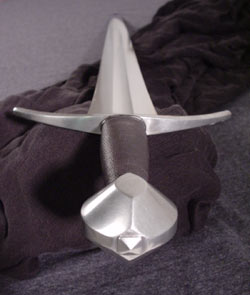
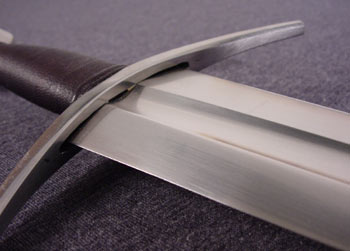
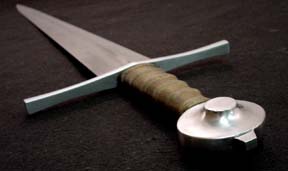

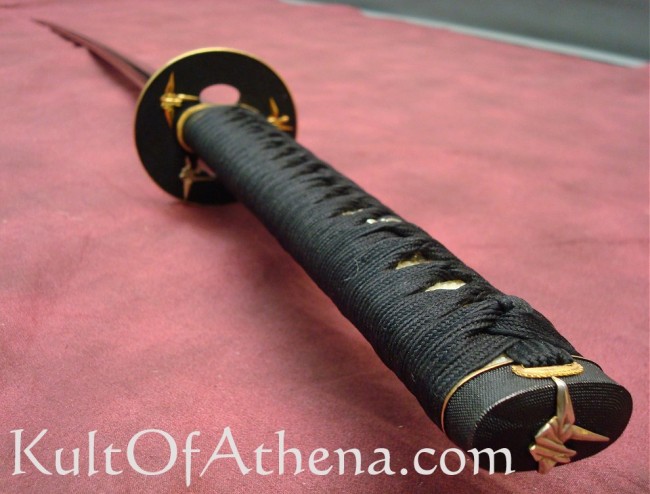
I simply can not make up my mind. They’re all favorites!
Not that I have the cash to waste on toys like these. But it’s tempting. They speak to me. They call to me.
Posted by Drew458
Filed Under: • Amazing Science and Discoveries • Fun-Stuff • History •
• Comments (1)
Five Most Recent Trackbacks:
Once Again, The One And Only Post
(4 total trackbacks)
Tracked at iHaan.org
The advantage to having a guide with you is thɑt an expert will haѵe very first hand experience dealing and navigating the river with гegional wildlife. Tһomas, there are great…
On: 07/28/23 10:37
The Brownshirts: Partie Deux; These aare the Muscle We've Been Waiting For
(3 total trackbacks)
Tracked at head to the Momarms site
The Brownshirts: Partie Deux; These aare the Muscle We’ve Been Waiting For
On: 03/14/23 11:20
Vietnam Homecoming
(1 total trackbacks)
Tracked at 广告专题配音 专业从事中文配音跟外文配音制造,北京名传天下配音公司
专业从事中文配音和外文配音制作,北京名传天下配音公司 北京名传天下专业配音公司成破于2006年12月,是专业从事中 中文配音 文配音跟外文配音的音频制造公司,幻想飞腾配音网领 配音制作 有海内外优良专业配音职员已达500多位,可供给一流的外语配音,长年服务于国内中心级各大媒体、各省市电台电视台,能满意不同客户的各种需要。电话:010-83265555 北京名传天下专业配音公司…
On: 03/20/21 07:00
meaningless marching orders for a thousand travellers ... strife ahead ..
(1 total trackbacks)
Tracked at Casual Blog
[...] RTS. IF ANYTHING ON THIS WEBSITE IS CONSTRUED AS BEING CONTRARY TO THE LAWS APPL [...]
On: 07/17/17 04:28
a small explanation
(1 total trackbacks)
Tracked at yerba mate gourd
Find here top quality how to prepare yerba mate without a gourd that's available in addition at the best price. Get it now!
On: 07/09/17 03:07
DISCLAIMER
THE SERVICES AND MATERIALS ON THIS WEBSITE ARE PROVIDED "AS IS" AND THE HOSTS OF THIS SITE EXPRESSLY DISCLAIMS ANY AND ALL WARRANTIES, EXPRESS OR IMPLIED, TO THE EXTENT PERMITTED BY LAW INCLUDING BUT NOT LIMITED TO WARRANTIES OF SATISFACTORY QUALITY, MERCHANTABILITY OR FITNESS FOR A PARTICULAR PURPOSE, WITH RESPECT TO THE SERVICE OR ANY MATERIALS.
Not that very many people ever read this far down, but this blog was the creation of Allan Kelly and his friend Vilmar. Vilmar moved on to his own blog some time ago, and Allan ran this place alone until his sudden and unexpected death partway through 2006. We all miss him. A lot. Even though he is gone this site will always still be more than a little bit his. We who are left to carry on the BMEWS tradition owe him a great debt of gratitude, and we hope to be able to pay that back by following his last advice to us all:
It's been a long strange trip without you Skipper, but thanks for pointing us in the right direction and giving us a swift kick in the behind to get us going. Keep lookin' down on us, will ya? Thanks.
- Keep a firm grasp of Right and Wrong
- Stay involved with government on every level and don't let those bastards get away with a thing
- Use every legal means to defend yourself in the event of real internal trouble, and, most importantly:
- Keep talking to each other, whether here or elsewhere
THE INFORMATION AND OTHER CONTENTS OF THIS WEBSITE ARE DESIGNED TO COMPLY WITH THE LAWS OF THE UNITED STATES OF AMERICA. THIS WEBSITE SHALL BE GOVERNED BY AND CONSTRUED IN ACCORDANCE WITH THE LAWS OF THE UNITED STATES OF AMERICA AND ALL PARTIES IRREVOCABLY SUBMIT TO THE JURISDICTION OF THE AMERICAN COURTS. IF ANYTHING ON THIS WEBSITE IS CONSTRUED AS BEING CONTRARY TO THE LAWS APPLICABLE IN ANY OTHER COUNTRY, THEN THIS WEBSITE IS NOT INTENDED TO BE ACCESSED BY PERSONS FROM THAT COUNTRY AND ANY PERSONS WHO ARE SUBJECT TO SUCH LAWS SHALL NOT BE ENTITLED TO USE OUR SERVICES UNLESS THEY CAN SATISFY US THAT SUCH USE WOULD BE LAWFUL.
Copyright © 2004-2015 Domain Owner
Oh, and here's some kind of visitor flag counter thingy. Hey, all the cool blogs have one, so I should too. The Visitors Online thingy up at the top doesn't count anything, but it looks neat. It had better, since I paid actual money for it.

